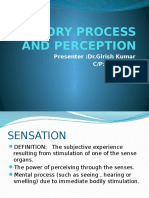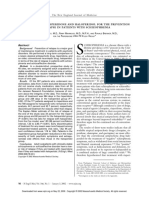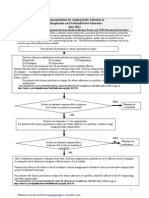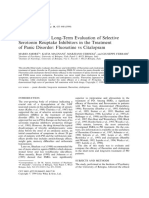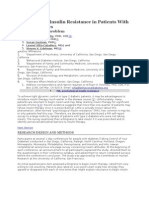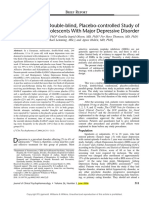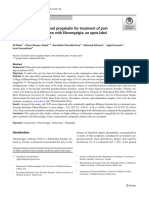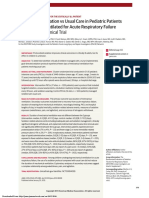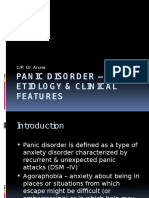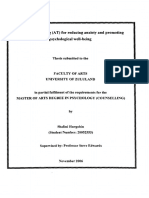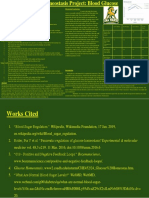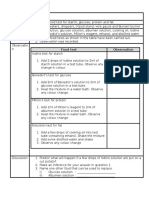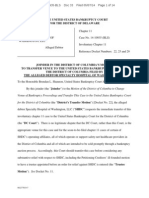Journal Club
Journal Club
Uploaded by
drkadiyala2Copyright:
Available Formats
Journal Club
Journal Club
Uploaded by
drkadiyala2Original Description:
Original Title
Copyright
Available Formats
Share this document
Did you find this document useful?
Is this content inappropriate?
Copyright:
Available Formats
Journal Club
Journal Club
Uploaded by
drkadiyala2Copyright:
Available Formats
Presented by Dr Pavan kumar Chair Person: Dr Denzil Pinto
Stanley N. Caroff, MD; Vicki G. Davis, DrPH; Del D. Miller, PharmD, MD; Sonia M. Davis, DrPH; Robert A. Rosenheck, MD; Joseph P. McEvoy, MD; E. Cabrina Campbell, MD; Bruce L. Saltz, MD; Silvana Riggio, MD; Miranda H. Chakos, MD; Marvin S. Swartz, MD; Richard S. E. Keefe, PhD; T. Scott Stroup, MD, MPH; and Jeffrey A. Lieberman, MD, for the CATIE Investigators
Stanley N. Caroff, MD,
Veterans Affairs Medical Center-116A, University & Woodland Avenues, Philadelphia, PA 19104 email: stanley.caroff@va.gov
Journal of Clinical Psychiatry 2011;72(3):295303
Supported by Clinical Antipsychotics Trials of
Intervention Effectiveness project(CATIE), National Institute of Mental Health. Study based on results from CATIE.
The Clinical Antipsychotic Trials of Intervention
Effectiveness project (CATIE) is a research project to evaluate the clinical effectiveness of atypical antipsychotics in the treatment of schizophrenia and Alzheimer's disease.
Previous published studies are Predominantly short-term studies designed for regulatory approval and labeling language. Comparators are either placebo or a single active agent (usually haloperidol) Results have limited generalizability because they lack representative patient samples, clinical settings and treatment conditions Existing studies do not address critical clinical and policy questions Sponsored by pharmaceutical companies
DSM-IV schizophrenia,
18-65 years old
Not first-episode or treatment resistant Concomitant medications, medical illnesses,
substance use disorders allowed Conducted at 57 geographically, demographically and organizationally diverse sites
How do the second generation antipsychotics
compare with a representative first generation antipsychotic? What is the comparative effectiveness of the second generation antipsychotic drugs? Are the second generation antipsychotics cost-effective?
Participants 1600 people with schizophrenia Trial duration Subjects participate for 18 months Design Practical trial that is a hybrid of efficacy and effectiveness trial designs
Overall, the medications were comparably effective but
were associated with high rates of discontinuation due to intolerable side effects or failure to adequately control symptoms. Olanzapine, was slightly better than the other drugs but also was associated with significant weight-gain as a side-effect The older, less expensive medication (perphenazine) used in the study generally performed as well as the four newer medications
The newer medications have no substantial advantage
over the older medication used in this study. An important issue still to be considered is individual differences in patient response to these drugs
NIMH Clinical Antipsychotic Trials of Intervention Effectiveness Study (CATIE) Phase 1 Results
Abnormal, involuntary movements of the tongue,
jaw, trunk, or extremities that develop in association with the use of neuroleptic medication. The movements are present over a period of at least 4 weeks and may be choreiform (rapid, jerky, nonrepetitive), athetoid (slow, sinuous, continual), or rhythmic (e.g., stereotypies) in nature.
The signs or symptoms develop during exposure to
a neuroleptic medication or within 4 weeks of withdrawal from an oral (or within 8 weeks of withdrawal from a depot) neuroleptic medication.
There must be a history of the use of neuroleptic
medication for at least 3 months (or 1 month if age 60 years or older).
The movements must not be due to a neurological
or other general medical condition
(e.g., Huntington's disease, Sydenham's chorea, spontaneous dyskinesia, hyperthyroidism, Wilson's disease), to ill-fitting dentures, or to exposure to other medications that can cause acute reversible dyskinesia (e.g., L-dopa, bromocriptine).
The movements should also not be better
accounted for by a neuroleptic-induced acute movement disorder
(e.g., Neuroleptic-Induced Acute Dystonia, Neuroleptic-Induced Acute Akathisia).
The likelihood of tardive dyskinesia (TD) being
irreversible served as a major impetus in antipsychotic drug development. Although controversy arose over the severity and reversibility of TD, a consensus emerged that TD followed a persistent or fluctuating course, but gradually stabilized or diminished, with few patients showing progression.
Data on the change in prevalence of TD during
treatment have been inconclusive, with some studies showing an increase and others, a decrease or no change at all.
Although estimates have varied, roughly 50% of
patients have persistent TD symptoms, 10% to 30% have a reduction in symptoms, and 10% to 30% show increased symptoms during treatment.
Long-term studies estimated that from 2% to 23% of
patients show loss of observable TD symptoms during treatment with first generation drugs(FGAs). Similarly, studies of second-generation agents have shown reduction of TD ratings, with some showing greater reductions, lesser reductions or no difference compared with first-generation agents.
Several cross-sectional studies have found an association
between TD and severity of cognitive deficits , as well as positive and negative symptoms of schizophrenia. Several prospective studies have shown that the presence of TD in schizophrenia correlates with poor response to treatment, lower rates of symptom remission , longer hospital stays , greater risk of relapse ,lower quality of life and functioning, a progressive course, and higher mortality. TD may be a phenotypic manifestation of a more severe, chronic , and refractory subtype of schizophrenia.
Because medication withdrawal risks relapse in
schizophrenia, it became important to examine the course of TD while maintaining antipsychotic treatment. Studying the course of TD in parallel with clinical symptoms is also important because of evidence suggesting an association between TD, symptom severity, treatment response, and prognosis of schizophrenia.
the patients with TD at baseline are more likely to
discontinue treatment for any cause compared with non-TD patients; the course of TD varies among individuals; and there are no differences between second-generation antipsychotics in the outcome of dyskinesias or symptoms of schizophrenia in patients with TD.
STUDY SETTING AND DESIGN Post hoc study analysis based on the CATIE Schizophrenia Trial 57 US sites Between January 2001 and December 2004
The CATIE Schizophrenia Trial offered the
opportunity to examine treatment response in a large sample of schizophrenia patients with TD at baseline randomly assigned to receive second-generation antipsychotics compared to patients without TD in the setting of a controlled trial. In addition, allowed to delineate the course of TD during treatment with second-generation antipsychotics, thereby enabling the development of treatment recommendations for management of symptoms of both schizophrenia and dyskinesias in patients with existing TD.
Treatment phases
Phase 1: patients were randomly assigned to receive
olanzapine, perphenazine, quetiapine, risperidone, or ziprasidone under double-blind conditions and studied for up to 18 months or until treatment was discontinued for any reason. Phase 1a : Patients with TD were excluded from randomisation to perphenazine and were assigned to one of the 4 second-generation antipsychotics.
Ziprasidone was approved for use by US FDA during
the trial and was added after 40 % of the patients had been enrolled. The data presented in the current report deal only with the time from initial randomisation until the first medication was discontinued for patients with TD(phase 1a) or without TD(phase 1).
Approved by an institutional review board at each site,
and written informed consent was obtained from all participants or their legally authorized representatives
Included 18-65 years of age Diagnosis of schizophrenia based on DSM 4th ed using SCID
Excluded if they had a Diagnosis of schizoaffective disorder, MR or Other cognitive disorders An unstable and serious medical condition Past adverse reactions to proposed treatments Treatment resistant schizophrenia First episode of schizophrenia Pregnant or Breast feeding
Total 1493 pts enrolled
33 pts excluded prior to analysis due to concerns about
data integrity 17 patients randomized did not take study medications 212 patients with TD but 12 of these were randomly assigned inadvertently to perphenazine and were excluded from the analysis.
200 patients randomly assigned to receive SGAs ,
who met modified Schooler-Kane criteria for TD at baseline having at least 1 AIMS item with a value of 3, or at least 2 items with a value of 2 at the baseline visit.
A comparison (non-TD) group consisted of 997 pts
assigned to receive SGA who didnt meet modified Schooler-Kane criteria for TD at baseline 67 pts had a h/o TD and 68 pts had 1 AIMS item rated 2 and excluded from secondary supportive analysis, yielding more restricted comparison group (n=862).
Identical-appearing capsules contained olanzapine
(7.5mg),quetiapine(200mg),risperidone(1.5mg),perph enazine(8mg), or ziprasidone (40 mg). Flexibly dosed with 1 to 4 capsules daily. Gradual transition to study medication over first few weeks. Concomitant medications were permitted, except for additional antipsychotics.
Modified Schooler-Kane criteria for TD using
Abnormal Involuntary Movement Scale
Positive and Negative Syndrome Scale (PANSS) Simpson-Angus Abbreviated Scale(SAS)
Barnes Akathisia Scale(BAS)
Basic socio-demographic data were recorded at baseline.
Screened for alcohol and drug abuse treatment with antipsychotics and anti-cholinergics, duration of illness Severity of symptoms measured using tools described
Clinical measures were collected at baseline, month 1,
month 3, and quarterly thereafter 18 months or time of treatment discontinuation.
Cognitive functioning was measured at baseline and
months 2, 6, and 18 by completing 11 neurocognitive tests, 5 neurocognitive domain scores were calculated from 9 neurocognitive test summary scores and standardized to create Z-scores for each domain. A neurocognitive composite score was calculated by creating Z-score of the average of the 5 standardized domain scores.
Primary clinical outcome measure time to all-cause treatment discontinuation, Secondary outcomes discontinuations for intolerability, inefficacy and patient decision; rates of discontinuations; mean modal dose; Change from baseline in the PANSS and neuro-cognitive composite scores. For all clinical measures, supportive analysis were also conducted (in which 135 patients with evidence of TD were excluded from non-TD group).
Kaplan-Meier survival curves
ANCOVA
Bonferroni correction for multiple corrections Chi square tests
nQuery Advisor
Patients Characteristics at Baseline: Compared with non-TD patients at baseline ,patients with TD were significantly older, with longer antipsychotic treatment but fewer recent exacerbations; higher ratings of symptom severity and acute EPS, lower neurocognitive scores; and were more likely have received anticholinergics, antipsychotics in general and first- generation antipsychotics
and DISCUSSION
RESULTS Compared with non-TD patients at baseline ,patients with TD were significantly older and chronically ill, with longer antipsychotic treatment but fewer recent exacerbations; higher ratings of symptom severity and acute EPS, lower neurocognitive scores; and were more likely have received anticholinergics, antipsychotics in general and first- generation antipsychotics
DISCUSSION
Effects of age and duration of illness were adjusted for clinical analysis. Patients with severe symptoms may receive higher drug doses for long periods, with poor adherence, resulting in greater incidence of TD and EPS.
TD patients with higher acute EPS were likely to receive anticholinergics at baseline contributing to impaired cognition.
There was no significant difference between TD and non-TD
groups in time to discontinuation for any cause . No significant differences between groups in time to discontinuation due to efficacy, intolerability or patient decision. The rates of discontinuation were identical between the groups The median time to discontinuation was 4.7 months for the TD group versus 5.4 months for the non-TD group. Discontinuation due to intolerability in the TD group versus the non-TD group was significant only for ziprasidone. Median time to all-cause discontinuation for TD patients receiving SGAs olanzapine>quetiapine>risperidone>ziprasidone
RESULTS No statistical significant TD groupby-treatment interaction for all-cause time to discontinuation . Longer time to discontinuation for any cause on olanzapine compared to other treatments.
DISCUSSION TD by itself is unlikely to affect treatment discontinuation. Previous published study also reports The time to the discontinuation of treatment for any cause was significantly longer in the olanzapine group than in the quetiapine or risperidone group, but not in the perphenazine or ziprasidone group indicating treatment differences were not altered by TD status at baseline.
RESULTS Quitapine was similar to risperidone and ziprasidone in overall effectiveness in both TD and non-TD groups, ie..pts with TD didnt show a more robust response to quetiapine.
DISCUSSION In phase 1b of CATIE, patients with chronic schizophrenia who had just discontinued the older antipsychotic perphenazine for intolerability and acute EPS, quetiapine and olanzapine were more effective than risperidone, as reflected by longer time to discontinuation for any reason suggesting susceptible pts may be less tolerant of drugs likely to acute EPS but not by TD itself.
Discontinuation due to intolerability in the TD group versus the non-TD group was significant only for ziprasidone.
???
No significant change in PANSS score or general
psychopathology between TD and non-TD patient groups. Small but statistically significant difference in neurocognitive composite Z-score at 6 months between TD and non TD patients. Non-TD patients showed significant improvement in verbal memory and processing speed. No significant TD group-by-treatment interactions.
RESULTS
DISCUSSION
No significant change in PANSS score or Greater symptom severity among pts general psychopathology between TD with TD at baseline , similar degree of and non-TD patient groups. improvement in psychopathology compared to non-TD pts, thus proving that the schizophrenia ass with TD has poor response(US-SCAP study) is false when SGAs are used. No significant TD group-by-treatment interactions. Small but statistically significant difference in neurocognitive composite Z-score at 6 months between TD and non TD patients. Treatment with SGAs doesnt differ with TD status. Treatment with SGAs doesnt improve cognition in TD patients.
Mean modal dose
No significant difference between TD groups receiving
different SGAs. Higher mean modal dose of olanzapine for patients with TD(23.65mg) versus those without TD(19.65mg). Overall percentage of patients who received max daily dose of all treatments was nearly same for those with or without TD.
RESULTS Higher mean modal dose of olanzapine for patients with TD(23.65mg) versus those without TD(19.65mg).
DISCUSSION Not significant when corrected for multiple comparisions. Patients with TD had more severe psychopathology at base-line, perhaps requiring higher doses but this should apply for all treatment groups. Anticholinergic effects of olanzapine could have unmasked TD in some patients,adding them to TD group,but quietapine with highest rate of anticholinergic symptoms,didnt show similar dose effect. So the reasons for this are unclear
At 18 months, significant reduction in adjusted total AIMS scores
for all patients with TD at baseline. Similar reduction for all SGAs, no treatment differences noted. Mean SAS score decreased in TD patients but not significant BAS global score declined and was significant. Analyzing patients with TD, 55% met Schooler-Kane criteria at 2 consecutive visits post-baseline, 34% at all visits, 24% did not meet criteria for TD at any subsequent visit. No significance between treatment groups over % of TD patients meeting criteria for post-baseline. Only 7 % patients showed an increase in AIMS score of at least 50%, compared to 32% patients showed decrease of at least 50%. No significant association between use of first-generation antipsychotics prior to randomisation and TD during follow-up.
RESULTS Analyzing patients with TD, 55% met Schooler-Kane criteria at 2 consecutive visits post-baseline, 34% at all visits, 24% did not meet criteria for TD at any subsequent visit.
DISCUSSION Changes in TD were within the range of previous studies of FGAs and SGAs with similar % of pts showing increases, reduction or lack of diagnosable TD symptoms.
At 18 months, significant reduction in adjusted total AIMS scores for all patients with TD at baseline. Similar reduction for all SGAs, no treatment differences noted.
Limitation of study to show whether reductions in TD was due to remission or suppression as drugs cant be discontinued.
RESULTS Mean SAS(Simpson Angus Abbreviated scale) score decreased in TD patients but not significant. BAS global score declined and was significant
DISCUSSION Some investigators proposed suppression of TD is result of druginduced parkinsonism, this study found ratings of parkinsonism also declined during the study consistent that the antidyskinetic effect of antipsychotics is independent of their acute parkinsonian effects.
Post hoc analysis of CATIE study
CATIE was not designed to study the course and
correlates of TD No comprehensive measures of previous treatment history or onset of drug-induced movement disorders. Withdrawal dyskinesias (TD) may have occurred due to switching from prior antipsychotic to randomized CATIE treatment assignment in 1 month. Overcome by exclusion of 1-month visit from analysis. Training to rate movement disorders was not rigorousovercome by double-blind design.
No control over changes in antipsychotic doses
correlations between dose and long-term course of TD has not firmly established. High rate of discontinuations resulted in short duration of treatment and follow-up. But duration comparable to other studies. No attempt in dose reduction or withdrawal of drugs in trial, so cant say whether decreases in AIMS scores represented reversal or suppression of TD symptoms. Differences of cognition could have been affected by use of anticholinergics at baseline, other studies in CATIE found no interaction.
Longer duration of illness or greater age among TD pts
could have affect neurocognitive results-after covariate adjustment TD, pts still have significantly lower neurocognitive scores than non-TD pts. Primarily older patients and chronic course with long term exposure to antipsychotics-cant apply to other ages or stages of schizophrenia. Cant compare FGAs and SGAs as TD pts not assigned to perphenazine. Small no of pts in ziprasidone group limit conclusions Clozapine may be advantageous in treatment and dyskinesia outcomes but not included in this phase of study
TD may be associated with more severe psychopathology
and cognitive impairment in chronic schizophrenia. Patients with TD are equally likely to respond to treatment with any of these 4 SGAs compared to pts without TD except cognition Prognosis of TD was variable among individuals with majority of patients showing persistence or fluctuations between visits. Few patients showed significant increases in TD ratings during treatment. No significant differences between drug treatments on the course TD at dosages used in the trial.
TITLE Adequate , short, accurate, informative
AUTHORS The authors are from various universities from US. Most of the authors are consultants and has received grant/research support from drug companies which provided medications for the CATIE studies. Correspondence author Dr Caroff has been a consultant for Eli Lilly and has received research support from Pfizer and other drug companies. Approved by an institutional review board at each site
ABSTRACT: Brief and concise Fair and unbiased account of the paper INTRODUCTION AND REVIEW OF LITERATURE Brief and comprehensive Correct and necessary No important citations missing Has cited prior articles in favor as well as contrary to the results Has described reasons and need for the research project No explicit hypothesis.
AIMS AND OBJECTIVES Clear and unambiguous METHODOLOGY Place and period have been described Post hoc study analysis based on the CATIE Schizophrenia Trial Population representative of the general population
Sample size is large and sufficient.
Method of sample selection- random and double-
blind design blinding details ?? Probably no sample bias. Sample not homogenous, older and chronic course patients more. Socio-demographic as well as clinical variables studied Cases- no mention of co-morbid medical or neurological disorders that may affect TD. ? 12 patients randomly assigned to perphenazine were not assigned to others in phase 1b
Tools and Instruments suitable for investigation used.
But ?? neurocognitve tests used
Who administered? DSM IV criteria using SCID.
Procedure has been well described but details of some
missing in this journal although explained in previous CATIE study. Written informed consent was taken and research protocol passed by ethical committee Ethical
RESULTS Presented and described adequately Statistical methods suitable and appropriate, but discrepancy noted when different methods used. No obvious statistical manipulation
DISCUSSION Interpretation of data is justifiable & appropriate to study. Comparisons with previous studies & results for & against the study discussed. No important omissions Conclusions are reasonable
REFERENCES Adequate No important omissions
SUGGESTIONS
Thank u
You might also like
- Ipde ScreeningDocument4 pagesIpde Screeningdrkadiyala283% (6)
- Addenbrooke's Cognitive Examination in TeluguDocument6 pagesAddenbrooke's Cognitive Examination in Telugudrkadiyala250% (2)
- Mental RetardationDocument37 pagesMental Retardationdrkadiyala2100% (1)
- Sensory Process and PerceptionDocument58 pagesSensory Process and Perceptiondrkadiyala2No ratings yet
- CBT in ChildrenDocument39 pagesCBT in Childrendrkadiyala2100% (1)
- Comprehensive Guide To HerbsDocument197 pagesComprehensive Guide To HerbsMeschinohealth100% (2)
- P 007 OlanzapineDocument11 pagesP 007 OlanzapineBalasubrahmanya K. R.No ratings yet
- Donepezil For The Treatment of Agitation in Alzheimer's DiseaseDocument11 pagesDonepezil For The Treatment of Agitation in Alzheimer's DiseaseIulia MohaiNo ratings yet
- Remission in Schizophrenia: One-Year Italian Prospective Study of Risperidone Long-Acting Injectable (RLAI) in Patients With Schizophrenia or Schizoaffective DisorderDocument11 pagesRemission in Schizophrenia: One-Year Italian Prospective Study of Risperidone Long-Acting Injectable (RLAI) in Patients With Schizophrenia or Schizoaffective Disorderdr.cintaNo ratings yet
- DemenciaDocument8 pagesDemenciajuby30No ratings yet
- CATIE Trial Summary PaperDocument14 pagesCATIE Trial Summary PaperNim RodNo ratings yet
- Schizophrenia Treatment & Management - Approach Considerations, Antipsychotic Pharmacotherapy, Other PharmacotherapyDocument13 pagesSchizophrenia Treatment & Management - Approach Considerations, Antipsychotic Pharmacotherapy, Other PharmacotherapydilaNo ratings yet
- Jurnal Risperidone PDFDocument10 pagesJurnal Risperidone PDFChairizal Meiristica YanhaNo ratings yet
- BrexpiprazolDocument11 pagesBrexpiprazolastrogliaNo ratings yet
- Antipsychotic Medication: Schizophrenia TreatmentDocument22 pagesAntipsychotic Medication: Schizophrenia Treatmentnina9490No ratings yet
- 08 Aj 0844Document11 pages08 Aj 0844kenikirkucing2No ratings yet
- A Retrospective Cohort Study of Diabetes Mellitus and Antipsychotic Treatment in The United StatesDocument7 pagesA Retrospective Cohort Study of Diabetes Mellitus and Antipsychotic Treatment in The United StatesDeegh MudhaNo ratings yet
- Clozapine in Treatment of Schizophrenia: V. Burtea P. Ifteni A Teodorescu L. RogozeaDocument6 pagesClozapine in Treatment of Schizophrenia: V. Burtea P. Ifteni A Teodorescu L. RogozeaReza Badruun Syahrul HakimNo ratings yet
- Britishjournalofpsychiatry BRITISHJOURNALOFPSYCHIATRY (2001), 179,514 518 (2 0 0 1), 1 7 9, 5 1 4 5 1 8Document6 pagesBritishjournalofpsychiatry BRITISHJOURNALOFPSYCHIATRY (2001), 179,514 518 (2 0 0 1), 1 7 9, 5 1 4 5 1 8Imam FirdausNo ratings yet
- Is Aripiprazole An Effective Maintenance Treatment OptionDocument5 pagesIs Aripiprazole An Effective Maintenance Treatment OptionmissayayayaNo ratings yet
- Clozapine Alone Versus Clozapine and Risperidone With Refractory SchizophreniaDocument11 pagesClozapine Alone Versus Clozapine and Risperidone With Refractory SchizophreniawardahNo ratings yet
- 9130Document13 pages9130BimaNo ratings yet
- Alpha-Dihydroergocryptine vs. Pramipexole As Adjunct Symptomatic Treatment of Idiopathic Parkinson'sDocument9 pagesAlpha-Dihydroergocryptine vs. Pramipexole As Adjunct Symptomatic Treatment of Idiopathic Parkinson'sRizka Leonita FahmyNo ratings yet
- NDT 45697 Efficacy of Second Generation Antipsychotics in Patients at 061813Document8 pagesNDT 45697 Efficacy of Second Generation Antipsychotics in Patients at 061813twahyuningsih_16No ratings yet
- EB June1Document7 pagesEB June1amiruddin_smartNo ratings yet
- Schizophrenia Treatment & ManagementDocument16 pagesSchizophrenia Treatment & ManagementDimas Januar100% (2)
- A Randomized, Placebo-Controlled Trial of Citalopram For The Treatment of Major Depression in Children and AdolescentsDocument5 pagesA Randomized, Placebo-Controlled Trial of Citalopram For The Treatment of Major Depression in Children and AdolescentsSharon AdeleNo ratings yet
- Donepezil in Vascular Dementia: A Randomized, Placebo-Controlled StudyDocument9 pagesDonepezil in Vascular Dementia: A Randomized, Placebo-Controlled StudyDian ArdiansyahNo ratings yet
- Long-Acting Risperidone and Oral Antipsychotics in Unstable SchizophreniaDocument29 pagesLong-Acting Risperidone and Oral Antipsychotics in Unstable SchizophreniahermanfirdausNo ratings yet
- Antipsychotic Use in Children and Adolescents A.13Document7 pagesAntipsychotic Use in Children and Adolescents A.13jacopo pruccoliNo ratings yet
- A Comparison of Risperidone and Haloperidol For The Prevention of Relapse in Patients With SchizophreniaDocument8 pagesA Comparison of Risperidone and Haloperidol For The Prevention of Relapse in Patients With SchizophreniaIlham WahyuNo ratings yet
- Acute Phase - Treatment Response and Tolerability With PPLAT Initiated Shortly After Hospital Admission in Patients With SCZDocument12 pagesAcute Phase - Treatment Response and Tolerability With PPLAT Initiated Shortly After Hospital Admission in Patients With SCZsaxo001navyNo ratings yet
- The Choice of Drugs For Schizophrenia: New England Journal MedicineDocument3 pagesThe Choice of Drugs For Schizophrenia: New England Journal Medicinewiwin09No ratings yet
- Schizophrenia Research: Man Wang, Jian-Hua Tong, Gang Zhu, Guang-Ming Liang, Hong-Fei Yan, Xiu-Zhen WangDocument4 pagesSchizophrenia Research: Man Wang, Jian-Hua Tong, Gang Zhu, Guang-Ming Liang, Hong-Fei Yan, Xiu-Zhen WangSol ContrerasNo ratings yet
- Ajp.161.10.1837 2Document11 pagesAjp.161.10.1837 2HKANo ratings yet
- Guideline Summary NGC-6824: FDA Warning/Regulatory AlertDocument8 pagesGuideline Summary NGC-6824: FDA Warning/Regulatory AlertÜnal ZağliNo ratings yet
- Rivastigmine For Dementia Associated With Parkinson's Disease Current Neurology and Neuroscience ReportsDocument3 pagesRivastigmine For Dementia Associated With Parkinson's Disease Current Neurology and Neuroscience ReportsishitaNo ratings yet
- Clozapine and Haloperidol in ModeratelyDocument8 pagesClozapine and Haloperidol in Moderatelyrinaldiapt08No ratings yet
- Pharmacotherapy Relapse Prevention in Body Dysmorphic Disorder: A Double-Blind, Placebo-Controlled TrialDocument9 pagesPharmacotherapy Relapse Prevention in Body Dysmorphic Disorder: A Double-Blind, Placebo-Controlled Trialyeremias setyawanNo ratings yet
- Deberdt 2008Document8 pagesDeberdt 2008Lidia BorleanNo ratings yet
- New Findings On Antipsychotic Use in Children and Adolescents With Schizophrenia Spectrum DisordersDocument4 pagesNew Findings On Antipsychotic Use in Children and Adolescents With Schizophrenia Spectrum Disorderssaxo001navyNo ratings yet
- Efficacy and Safety of Paliperidone Palmitate Eca ADocument14 pagesEfficacy and Safety of Paliperidone Palmitate Eca AMaria Fernanda AbrahamNo ratings yet
- Recommendations For Antipsychotic Selection in Schizophrenia and Schizoaffective Disorders June 2012Document5 pagesRecommendations For Antipsychotic Selection in Schizophrenia and Schizoaffective Disorders June 2012Kunthi Kencana Makayasa PutriNo ratings yet
- The Prevalence, Risk Factors and Clinical Correlates of Obesity in Chinese Patients WithDocument20 pagesThe Prevalence, Risk Factors and Clinical Correlates of Obesity in Chinese Patients WithjhuNo ratings yet
- Behavioural abnormalities in children with new-onsetDocument6 pagesBehavioural abnormalities in children with new-onsetShubham ChauhanNo ratings yet
- wobrock2013Document8 pageswobrock2013bssNo ratings yet
- Correspondence: Prof. Saeed Farooq, MCPS, FCPS, Professor Department ofDocument2 pagesCorrespondence: Prof. Saeed Farooq, MCPS, FCPS, Professor Department ofKaram Ali ShahNo ratings yet
- Am J Addict 2009 HamiltonDocument6 pagesAm J Addict 2009 HamiltonalvmdNo ratings yet
- Long-Term Effects of The Concomitant Use of Memantine With Cholinesterase Inhibition in Alzheimer DiseaseDocument10 pagesLong-Term Effects of The Concomitant Use of Memantine With Cholinesterase Inhibition in Alzheimer DiseaseDewi SariNo ratings yet
- Hemodialysis and Peritoneal Dialysis - Patients' Assessment of Their Satisfaction With Therapy and The Impact of The Therapy On Their LivesDocument6 pagesHemodialysis and Peritoneal Dialysis - Patients' Assessment of Their Satisfaction With Therapy and The Impact of The Therapy On Their Livesmaria teresa pertuz rondonNo ratings yet
- Clinical Antipsychotic Trials of Intervention Effectiveness: (Catie)Document2 pagesClinical Antipsychotic Trials of Intervention Effectiveness: (Catie)vinodksahuNo ratings yet
- Short-Term and Long-Term Evaluation of Selective Serotonin Reuptake Inhibitors in The Treatment of Panic Disorder: Fluoxetine Vs CitalopramDocument6 pagesShort-Term and Long-Term Evaluation of Selective Serotonin Reuptake Inhibitors in The Treatment of Panic Disorder: Fluoxetine Vs CitalopramBakhita MaryamNo ratings yet
- Psychological Insulin Resistance in Patients With Type 2 DiabetesDocument8 pagesPsychological Insulin Resistance in Patients With Type 2 Diabeteskira0105No ratings yet
- Case Based Clinical Pearls - A Schizophrenic Case StudyDocument5 pagesCase Based Clinical Pearls - A Schizophrenic Case StudyTeofel John Alvizo PantaleonNo ratings yet
- Duloxetine Treatment For GADDocument8 pagesDuloxetine Treatment For GADWhitney FarrarNo ratings yet
- Cognitive Effects of Antipsychotic Drugs in First-Episode Schizophrenia and Schizophreniform Disorder: A Randomized, Open-Label Clinical Trial (EUFEST)Document8 pagesCognitive Effects of Antipsychotic Drugs in First-Episode Schizophrenia and Schizophreniform Disorder: A Randomized, Open-Label Clinical Trial (EUFEST)yeremias setyawanNo ratings yet
- A Randomized, Double-Blind, Placebo-Controlled Study of Citalopram in Adolescents With Major Depressive Disorder - Von Knorring 2006Document5 pagesA Randomized, Double-Blind, Placebo-Controlled Study of Citalopram in Adolescents With Major Depressive Disorder - Von Knorring 2006Julio JuarezNo ratings yet
- Panss ScoreDocument8 pagesPanss ScoretriaclaresiaNo ratings yet
- Pi Is 1059131106001208Document5 pagesPi Is 1059131106001208Murli manoher chaudharyNo ratings yet
- Olanzapine and BPD-olanzapina Si Personalitatea de Tip BorderlineDocument10 pagesOlanzapine and BPD-olanzapina Si Personalitatea de Tip Borderlineelvira9No ratings yet
- Hyperprolactinemia and Galactorrhea Induced by Serotonin and Norepinephrine Reuptake Inhibiting AntidepressantsDocument10 pagesHyperprolactinemia and Galactorrhea Induced by Serotonin and Norepinephrine Reuptake Inhibiting AntidepressantsSteven KatuukNo ratings yet
- Comparing Duloxetina and Pregabaline For Treatment of Pain and Depression in Women With Fibromyalgia and Open Label Randomized Clinical TrialDocument10 pagesComparing Duloxetina and Pregabaline For Treatment of Pain and Depression in Women With Fibromyalgia and Open Label Randomized Clinical TrialPsiquiatria para todosNo ratings yet
- Joi 140178Document11 pagesJoi 140178holisNo ratings yet
- Psychotropic Medication For Children and Adolescents With EDocument10 pagesPsychotropic Medication For Children and Adolescents With EloloasbNo ratings yet
- Atypical Antipsychotic Augmentation in Major Depressive DisorderDocument13 pagesAtypical Antipsychotic Augmentation in Major Depressive DisorderrantiNo ratings yet
- The Prevention and Treatment of Disease with a Plant-Based Diet Volume 2: Evidence-based articles to guide the physicianFrom EverandThe Prevention and Treatment of Disease with a Plant-Based Diet Volume 2: Evidence-based articles to guide the physicianNo ratings yet
- Egas MonizDocument17 pagesEgas Monizdrkadiyala2No ratings yet
- Collective BehaviourDocument53 pagesCollective Behaviourdrkadiyala2No ratings yet
- Click Icon To Add PictureDocument52 pagesClick Icon To Add Picturedrkadiyala2No ratings yet
- Assessment & Management of Dissociative Disorders: Chairperson: DR - Safeekh A.T. Presenter: Dr.D.ArchanaaDocument62 pagesAssessment & Management of Dissociative Disorders: Chairperson: DR - Safeekh A.T. Presenter: Dr.D.Archanaadrkadiyala2No ratings yet
- Anesthesia For TurpDocument5 pagesAnesthesia For Turpdrkadiyala2No ratings yet
- Panic Disorder With AgoraphobiaDocument55 pagesPanic Disorder With Agoraphobiadrkadiyala2100% (2)
- Bipolar DepressionDocument81 pagesBipolar Depressiondrkadiyala2No ratings yet
- DepressionDocument62 pagesDepressiondrkadiyala2No ratings yet
- Fat EmbolismDocument26 pagesFat Embolismdrkadiyala2No ratings yet
- Dialectical Behaviour TherapyDocument57 pagesDialectical Behaviour Therapydrkadiyala2No ratings yet
- Fat EmbolismDocument26 pagesFat Embolismdrkadiyala2No ratings yet
- Treatment Resistant OcdDocument70 pagesTreatment Resistant Ocddrkadiyala2100% (1)
- Vascular DementiaDocument57 pagesVascular Dementiadrkadiyala2No ratings yet
- Family TherapyDocument92 pagesFamily Therapydrkadiyala2100% (3)
- DeliriumDocument72 pagesDeliriumdrkadiyala2100% (2)
- Assessment & Management of Dissociative Disorders: Chairperson: DR - Safeekh A.T. Presenter: Dr.D.ArchanaaDocument62 pagesAssessment & Management of Dissociative Disorders: Chairperson: DR - Safeekh A.T. Presenter: Dr.D.Archanaadrkadiyala267% (3)
- Diagnosis, Assessment and Management of OCDDocument116 pagesDiagnosis, Assessment and Management of OCDdrkadiyala2100% (2)
- Etiology of OCD: Chairperson: DR Anupama Presenter: DR ChandiniDocument35 pagesEtiology of OCD: Chairperson: DR Anupama Presenter: DR Chandinidrkadiyala2No ratings yet
- Amnestic DisordersDocument52 pagesAmnestic Disordersdrkadiyala2No ratings yet
- Obsessive Compulsive Spectrum DisordersDocument62 pagesObsessive Compulsive Spectrum Disordersdrkadiyala2No ratings yet
- Panic Disorder - Etiology & Clinical FeaturesDocument49 pagesPanic Disorder - Etiology & Clinical Featuresdrkadiyala2No ratings yet
- Limbic Sys - ArchDocument85 pagesLimbic Sys - Archdrkadiyala2No ratings yet
- Aetiology & Clinical Features of Alzheimers DiseaseDocument100 pagesAetiology & Clinical Features of Alzheimers Diseasedrkadiyala2No ratings yet
- Hypochondriacal DisorderDocument61 pagesHypochondriacal Disorderdrkadiyala2No ratings yet
- Classification of Psychiatric DisordersDocument64 pagesClassification of Psychiatric Disordersdrkadiyala2100% (1)
- Germ TheoryDocument8 pagesGerm TheoryrasunraNo ratings yet
- Medical Essential CertificateDocument2 pagesMedical Essential Certificateapi-216708592No ratings yet
- Ronald Glick, MD Medical Director-Center For Integrative Medicine at UPMC ShadysideDocument42 pagesRonald Glick, MD Medical Director-Center For Integrative Medicine at UPMC ShadysideAnonymous LXV7Pwp100% (1)
- Autogenic Training For Reducing Anxiety & Promoting Psychological Well-Being - S HurgobinDocument85 pagesAutogenic Training For Reducing Anxiety & Promoting Psychological Well-Being - S HurgobinmichanNo ratings yet
- Cognitive Behavorial Therapy A Case Study of Breavement Marshall UniversityDocument9 pagesCognitive Behavorial Therapy A Case Study of Breavement Marshall UniversityInternational Journal of Innovative Science and Research TechnologyNo ratings yet
- Men's Health UK - March 2019 PDFDocument132 pagesMen's Health UK - March 2019 PDFDIPOLMEDIANo ratings yet
- Sma Drug Pipeline: Basic Research Seed IdeasDocument1 pageSma Drug Pipeline: Basic Research Seed IdeassvaleravnNo ratings yet
- SF 8 - G8silverDocument93 pagesSF 8 - G8silverKristina Lyka OpadaNo ratings yet
- Lab Report - Sports and Energy DrinksDocument12 pagesLab Report - Sports and Energy Drinksdjbj85100% (2)
- Homeostasis Project PosterDocument2 pagesHomeostasis Project Posterapi-386099492No ratings yet
- Learning Activity Sheet in TLE (Wellness Massage) : Third Quarter-Week 4Document12 pagesLearning Activity Sheet in TLE (Wellness Massage) : Third Quarter-Week 4Kim Caguioa100% (4)
- Cutaneous Larva MigransDocument4 pagesCutaneous Larva MigransanissabilfaqihNo ratings yet
- Bioavailability and BioequivalenceDocument39 pagesBioavailability and Bioequivalenceنور الهدىNo ratings yet
- SFH Mod 4Document14 pagesSFH Mod 4goutami SunthankarNo ratings yet
- Sacroiliac Joint Clinical Prediction Rule: Invited CommentaryDocument2 pagesSacroiliac Joint Clinical Prediction Rule: Invited CommentaryrapannikaNo ratings yet
- Glaukoma Setelah Operasi Katarak KongenitalDocument21 pagesGlaukoma Setelah Operasi Katarak KongenitalAgustianeMawarniAlyNo ratings yet
- ChemoDocument32 pagesChemoJehannah Dayanara HayudiniNo ratings yet
- Experiment Food TestDocument3 pagesExperiment Food TestNursabiha Che MazlanNo ratings yet
- DVT Case StudyDocument2 pagesDVT Case StudyCrystal B Costa78No ratings yet
- Energy Brochure PDFDocument2 pagesEnergy Brochure PDFSampath ReddyNo ratings yet
- Procedure ChargesDocument5 pagesProcedure ChargesSyed RuksarNo ratings yet
- Endo VacDocument5 pagesEndo Vacisha MehtaNo ratings yet
- Management of Venous Leg Ulcers: Clinical Practice Guidelines of The Society For Vascular Surgery and The American Venous ForumDocument57 pagesManagement of Venous Leg Ulcers: Clinical Practice Guidelines of The Society For Vascular Surgery and The American Venous ForumlintangNo ratings yet
- Journal Reading Ilmu Penyakit DalamDocument15 pagesJournal Reading Ilmu Penyakit DalamSeffia riandiniNo ratings yet
- Related ReadingsDocument2 pagesRelated ReadingsIra BearNo ratings yet
- CLEP Introductory Psychology VocabularyDocument7 pagesCLEP Introductory Psychology VocabularyThomas SlifkaNo ratings yet
- Venue of Bankruptcy Proceedings and Transfer This Case To The United States Bankruptcy Court For The District of Columbia (The "District's Transfer Motion") (Docket No. 22), The AllegedDocument14 pagesVenue of Bankruptcy Proceedings and Transfer This Case To The United States Bankruptcy Court For The District of Columbia (The "District's Transfer Motion") (Docket No. 22), The AllegedChapter 11 DocketsNo ratings yet
- M28 Mood and AffectDocument34 pagesM28 Mood and AffectRNStudent1No ratings yet
- Human Pharmaceuticals in EnvironmentDocument302 pagesHuman Pharmaceuticals in EnvironmentJuan JácomeNo ratings yet



